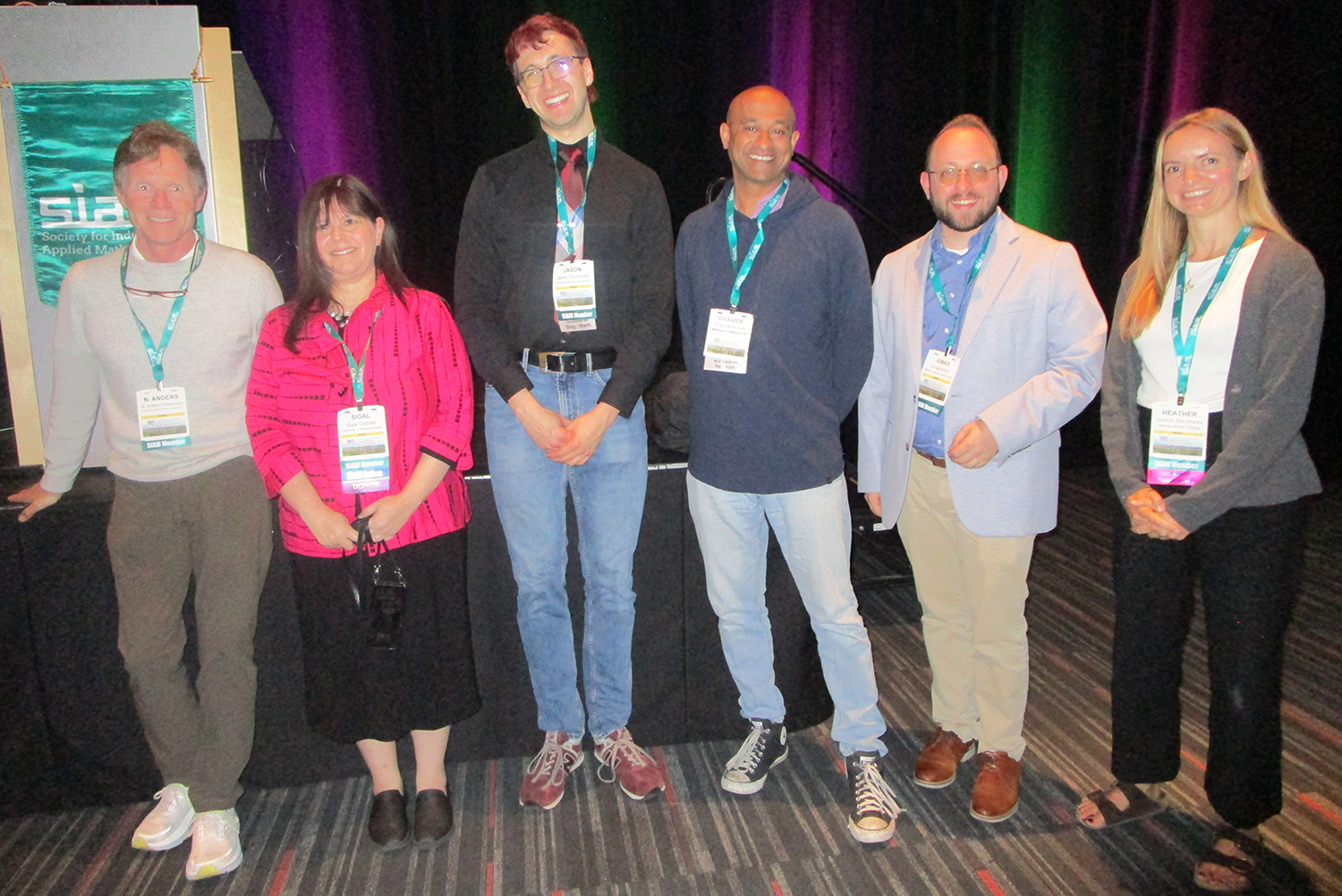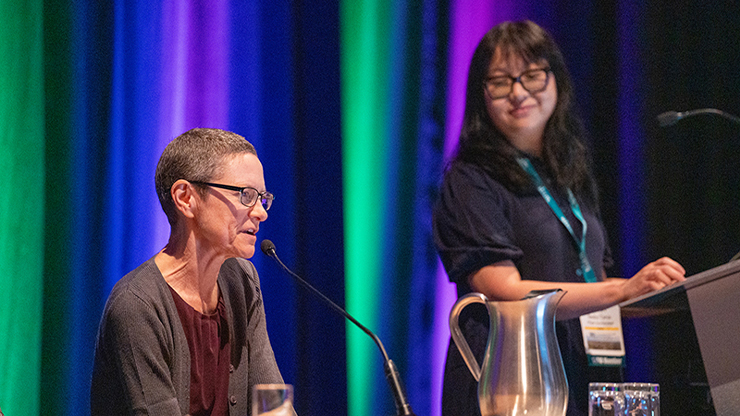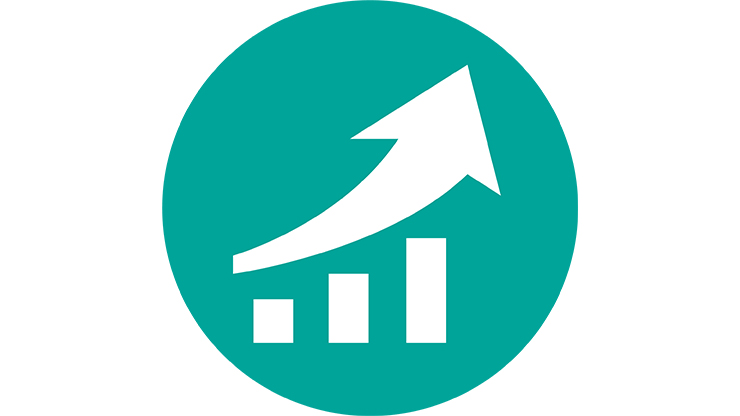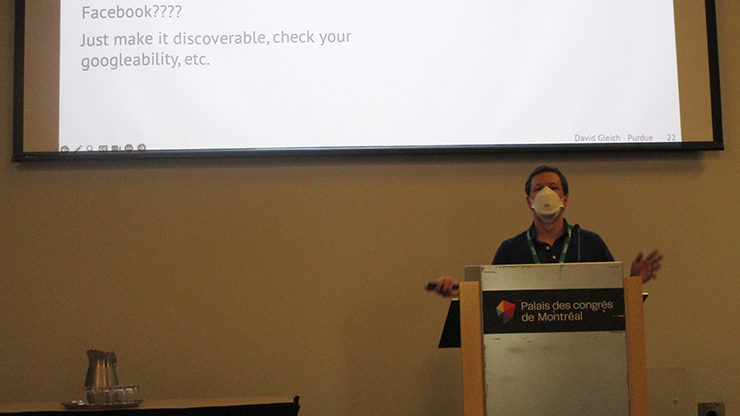Career Opportunities Panel at AN25 Compares Employment Experiences Within and Beyond Academia
As graduate students and junior researchers prepare to enter the workforce, they face numerous decisions about the direction of their future employment. Some may wish to embark on tenure-track academic careers, while others might be drawn to opportunities in industry, government, or the U.S. Department of Energy’s 17 National Laboratories. Given the versatility of a science, technology, engineering, and mathematics (STEM) education, there is no single path to success.
During the Third Joint SIAM/CAIMS Annual Meetings, which took place this summer in Montréal, Québec, Canada, a comprehensive panel discussion explored the myriad career options that are available to applied mathematicians, computational scientists, and data scientists. The panel, which was sponsored by SIAM’s Career Opportunities Committee and chaired by Jason Torchinsky of Sandia National Laboratories, featured Jonas Actor of Sandia, Dhavide Aruliah of MKDA Consulting, Heather Zinn Brooks of Harvey Mudd College, Sigal Gottlieb of the University of Massachusetts (UMass) Dartmouth, and Anders Petersson of Lawrence Livermore National Laboratory. Throughout the session, the speakers reflected on their individual trajectories, shared personal observations, and fielded questions from the audience.
As the conversation commenced, each speaker summarized the experiences that led to their current roles. Aruliah earned a B.Sc. and M.Sc. in mathematics and a Ph.D. in computer science, then completed two postdoctoral placements before joining the faculty at the University of Ontario Institute of Technology. Although he went on to receive tenure and was eligible for full professorship, he chose to leave academia in favor of industry because he did not feel comfortable counseling students about industry-based careers without having experienced one himself. Aruliah worked remotely for several different companies before ultimately founding MKDA Consulting.
Next, Petersson overviewed the path that led him to the national labs. He obtained a master’s degree and Ph.D. in his home country of Sweden, then moved to the U.S. to conduct postdoctoral research at Los Alamos National Laboratory and the University of California, Los Angeles. Petersson briefly returned to Sweden as a faculty member at Chalmers University of Technology, where he studied fluid mechanics applications for a few years before switching to industry. When he eventually received a call from a colleague about a job opening at Lawrence Livermore back in the U.S., he accepted the position and has been at the lab for the past 26 years.
Gottlieb earned her Ph.D. from Brown University, after which she remained at Brown for a year as a postdoctoral researcher and then joined UMass Dartmouth as an assistant professor. More than 25 years later, she is now the university’s Chancellor Professor of Mathematics. “In many senses, I’m not working in the same place because it’s changed so much,” she said, explaining that she has helped establish new graduate programs and launch the Center for Scientific Computing and Data Science Research.

Actor, who is currently a Senior Member of Technical Staff at Sandia, holds an M.A. and Ph.D. in computational and applied mathematics. Much of his graduate work focused on the interdisciplinary side of bioinformatics and data science, and he was ultimately drawn to the national laboratories by the prospect of building machine learning models with guarantees. Actor noted that the labs tend to value candidates with a traditional background in applied math, a thorough understanding of data science and data pipelines, and a demonstrated ability to leverage their skills within a changing landscape.
Brooks discovered her love of math in college and switched her area of study accordingly. “I didn’t plan to go to grad school, but I had a wonderful mentor at the University of Utah who suggested that I apply to the graduate program,” she said, adding that she was particularly interested in teaching. “It was in graduate school that I realized how wonderful a career in mathematics would be, and what a good fit it was for me.” Brooks is now in her sixth year as an assistant professor at Harvey Mudd—a small, STEM-focused liberal arts college—and is coming up for tenure. “A liberal arts career path is an excellent option if you want a lot of flexibility in how you’re allocating your time,” she said. “I have an environment with supportive colleagues where I can choose—to some extent—how much time I allocate to research, teaching, and other service or professional development opportunities.”
After these introductions, panelists shared pieces of advice that have shaped their perspectives. Actor recalled valuable guidance from a graduate school faculty member that has stuck with him over the years. “You don’t have to know all of the answers when you start out,” he said. “That’s true at the beginning of your career, and it’s also true as you go through your career.” Gottlieb agreed, disclosing that she would have likely felt more confident in her early days as an assistant professor had she accepted this maxim. “I wish I knew earlier that the way we learn and develop competence is by trial and error,” she said. “Doing things without knowing how to do them is exactly how you learn; you figure it out on the fly.”
Brooks urged attendees to ask questions at every stage of their professional journeys and remain open to new experiences — even ones that do not necessarily align with their imagined future visions. “It’s good to plan ahead, think about opportunities, and prepare for them, but you can’t predict where the world will be in five or 10 years,” Brooks said. “You really just have to be open to following things that you’re excited about. Trust your curiosity and your instincts.”
When an audience member inquired about the realities of the present job market, Aruliah acknowledged the difficulties that are associated with funding cuts in the U.S. but reminded listeners that economic downturns tend to correct themselves with time. “It’s a bit of a brutal job market right now, I don’t want to lie to you about that,” he said, admitting that his own consulting business is feeling the effects of continued uncertainty. Gottlieb concurred that the academic job scene is similarly unpredictable, given questions about funding, grants, and institutions’ capacities to support postdoctoral researchers. Aruliah hence advised job seekers to use this time to hone their skillsets in anticipation of future openings. “One thing that I’ve come to embrace is that fortune favors the ready,” he said. “Think about the skills and experiences that you hope to have when things improve a little.”
Conversation then turned to optimal funding strategies. Gottlieb, who spent six months as interim Vice Chancellor for Research at UMass Dartmouth, remarked that universities typically have some incentive to assist with grant writing. Even so, most academics who wish to run a project from start to finish will need to secure multiple simultaneous grants. A wide professional network is valuable under these circumstances, as existing connections can lead to collaborations with other researchers who may have accessible funding and a real interest in the study. “It’s not what you know, it’s who you know,” Petersson said. “If you build your network of contacts, that can help your situation.”
Brooks clarified that while grants and other sources of federal funding are certainly critical within academia, private sponsorship can serve as an additional resource for university researchers. She mentioned that most colleges have designated fundraising teams and/or departments that can promote scientists’ projects, get donors excited about potential matchmaking, and generate opportunities for private funds.
Petersson then addressed funding within the national laboratories, which have internal sources of revenue for startup ideas — though this money is quite competitive. “If you have a good story, you can get funding that may last for three years,” he said. “But at the end of those years, you’re encouraged to find additional funding.” Therefore, the goal is to amass enough results to motivate external funders to support the ongoing venture. Actor thus recommended that lab employees build compelling portfolios—comprised of multiple smaller projects that serve as proofs of concept—that contribute to a unified yet versatile theme within the larger research landscape.
Next, the discussion shifted to networking. When an attendee expressed trepidation about their ability to engage in intellectual dialogue with more senior researchers, Brooks reminded them that all established professionals were once junior scientists themselves. “It’s really helpful to remember that the people you’re talking to are just people,” she said. “Networking doesn’t have to be all research, all business, all the time. Human connections are never a waste of time.”
Aruliah likewise encouraged early-career researchers to try to connect personally with their conversation partners at conferences and elsewhere, as exhibiting genuine interest in one’s peers typically elicits a positive response. Actor agreed and suggested that attendees initiate conversations with researchers whose projects they admire, as such interactions can serendipitously lead to internships, postdoctoral placements, academic collaborations, and so forth. He also noted that scientists typically like to talk about their own work. “Try to get other people talking about what interests them,” Actor said. “People think you’re a great conversationalist if you listen.”
When considering a job offer, Actor prompted job seekers to evaluate both the workplace culture and any prospective collaborators within the company, department, or group to ensure that the position is a good fit. Positive relationships with colleagues are especially important in academia, as people tend to remain in academic positions for a long time; in contrast, industry sees a much greater level of turnover. Gottlieb stated that applicants may want to talk to former employees to find out why they left the organization in question. “The people you work with are the most important,” she said. “When things at an institution change but the colleagues don’t, that makes it a good place to be.”
As the session drew to a close, the panelists advised the audience to stay positive about their futures, remain flexible in the face of ongoing uncertainty, and hone their unique skillsets however possible. “Demonstrate excellence and have something in reserve where you know you can be the best at what you’re doing,” Actor said. “Know what’s open and available, line yourself up to apply, and leverage your connections to get there. If you make sure that you stand out, you’ll position yourself in a better place.”
About the Author
Lina Sorg
Managing editor, SIAM News
Lina Sorg is the managing editor of SIAM News.

Stay Up-to-Date with Email Alerts
Sign up for our monthly newsletter and emails about other topics of your choosing.






